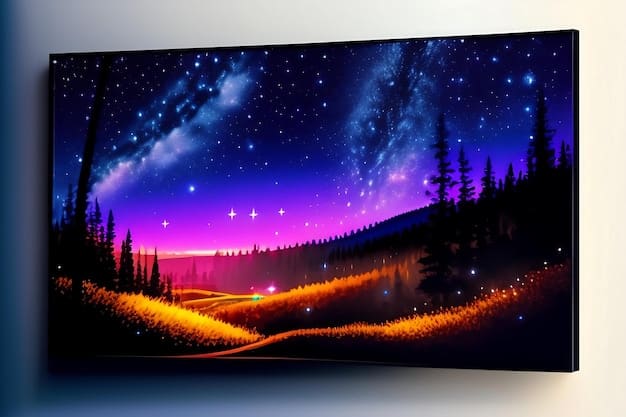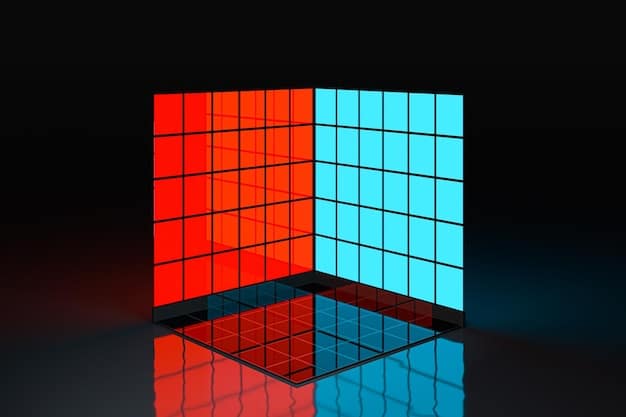OLED vs QLED: Understanding the Differences and Choosing the Right TV

Advertisements
Understanding the Differences Between OLED and QLED TVs: Which is Right for You? This article explores the key distinctions between OLED and QLED TVs, focusing on picture quality, price, lifespan, and viewing experience to help you choose the best TV for your needs.
Choosing a new TV can be a daunting task, especially when faced with acronyms like OLED and QLED. Understanding the Differences Between OLED and QLED TVs: Which is Right for You? depends on several factors, from your budget and viewing habits to the importance you place on picture quality and energy efficiency.
Advertisements
OLED vs QLED: What’s the Core Difference?
When diving into the world of modern televisions, two technologies frequently come up: OLED and QLED. While both promise stunning picture quality, they achieve it in very different ways. Understanding these differences is crucial to making an informed decision.
OLED: Emissive Technology
OLED, which stands for Organic Light Emitting Diode, uses a fundamentally different approach. Each pixel in an OLED screen is self-emissive, meaning it produces its own light and color. When a pixel needs to be black, it simply turns off.
Advertisements
QLED: LCD with Quantum Dots
QLED, or Quantum Dot LED, is essentially an advanced form of LCD (Liquid Crystal Display) technology. QLED TVs uses an LED backlight to shine light through a layer of quantum dots, which are tiny crystals that emit specific colors when illuminated.

In summary, OLED creates light at the pixel level, offering unmatched black levels and contrast, while QLED relies on a backlight and quantum dots to enhance color and brightness.
Picture Quality: OLED’s Perfect Blacks vs. QLED’s Brightness
Picture quality is often the deciding factor for many when choosing a TV. Both OLED and QLED offer excellent image quality, but their strengths lie in different areas.
- Black Levels and Contrast: OLED reigns supreme here. Because OLED pixels can completely turn off, they achieve perfect blacks, resulting in an infinite contrast ratio.
- Brightness: QLED TVs generally get brighter than OLEDs. This makes them better suited for brightly lit rooms where glare can be an issue.
- Color Accuracy and Volume: Both technologies offer excellent color accuracy, but QLED TVs often excel in color volume, meaning they can maintain vibrant colors even at high brightness levels.
Ultimately, the best picture quality depends on your viewing environment and personal preferences. If you value deep blacks and high contrast, OLED is the winner. If you need a bright screen for a sunny room, QLED might be a better choice.
Viewing Angle and Uniformity: Where Do They Stand?
Beyond brightness and contrast, viewing angle and screen uniformity are important considerations for overall picture quality and viewing experience. These factors can significantly impact how you perceive the image, especially when watching with a group.
OLED generally offers wider viewing angles than QLED. The image quality on an OLED TV remains consistent even when viewed from off-center, which is great for large rooms or when people are sitting at different angles.
- QLED potential issues: On a QLED TV, the picture can appear washed out or the colors can shift when viewed from an angle.
- Uniformity issues: Also, with local dimming, the edge-lit LEDs in QLED displays may cause uneven brightness, known as “dirty screen effect”, especially during scenes with large areas of uniform color.
Therefore, OLED typically offers a more consistent picture quality, while QLED screens are prone to color and brightness deviations at wider angles.

Lifespan and Burn-In: Addressing Concerns
In the early days of OLED technology, burn-in was a significant concern. Burn-in occurs when static elements, such as channel logos or HUDs (heads-up displays) in video games, are displayed on the screen for extended periods, causing permanent image retention.
Modern OLED TVs use advanced technologies to mitigate the risk of burn-in. These include pixel shifting, which subtly moves the image to prevent static elements from remaining in the same place for too long, and screen savers that dim the display when it’s not actively in use.
QLED TVs do not suffer from burn-in because they use a different technology. The quantum dots are inorganic and do not degrade over time like the organic materials in OLEDs. As for the lifespan, both OLED and QLED TVs are designed to last for many years. QLEDs tends to have a longer lifespan.
In short, burn-in is less of a concern with modern OLED TVs, with the QLED TV having a longer lifespan. With reasonable usage, both technologies should provide many years of enjoyment.
Pricing and Value: What’s Your Budget?
Price is always a major factor when making a purchase, and the cost of OLED and QLED TVs can vary significantly depending on the manufacturer, screen size, resolution, and features.
Generally, OLED TVs tend to be more expensive than QLED TVs, especially at larger screen sizes. This is due to the more complex manufacturing process involved in producing OLED panels. However, prices have been coming down in recent years as OLED technology becomes more mature.
When evaluating value, consider not only the initial cost but also the features and performance you’re getting for your money. If you’re on a tight budget, a QLED TV may offer a better balance of price and performance. However, if you’re willing to spend more for the best possible picture quality, an OLED TV is worth the investment.
To summarise, set a realistic budget, compare prices from different retailers, and weigh the cost difference against the performance benefits of each technology.
Applications: Which is Better for Gaming or Movies?
Depending on what you primarily use your TV for, one technology might be better suited than the other. Here’s a breakdown of how OLED and QLED perform in different scenarios:
- Movies: OLED’s infinite contrast ratio and perfect blacks make it ideal for watching movies, especially in a dark room. The deep blacks enhance the cinematic experience and bring out details in shadows.
- Gaming: Both OLED and QLED TVs offer low input lag and fast response times, which are crucial for gaming. However, OLED’s near-instant pixel response time results in smoother motion and less blur, giving you a competitive edge.
- Sports: QLED’s high brightness can be an advantage for watching sports, especially during daytime viewing. The bright screen helps to overcome glare and makes the action easier to see.
Choose an OLED if your a movie or gamer enthuasist. Also, if you watch sports mainly go with QLED.
| Key Point | Brief Description |
|---|---|
| 💡 OLED Technology | Self-emissive pixels for perfect blacks and infinite contrast. |
| 🌈 QLED Technology | LCD enhanced with quantum dots for higher brightness and color volume. |
| 💰 Price | OLEDs are generally more expensive, especially at larger sizes. |
| 🎮 Best Use | OLED for dark room viewing and gaming; QLED for bright environments and sports. |
Frequently Asked Questions (FAQ)
▼
The main advantage of OLED TVs is their ability to produce perfect black levels and infinite contrast ratios, leading to exceptional picture quality, especially in dark environments.
▼
Yes, QLED TVs are generally better suited for bright rooms due to their higher brightness levels, which help to overcome glare and maintain vibrant colors even in well-lit environments.
▼
Burn-in is less of a concern with modern OLED TVs due to technologies like pixel shifting and screen savers. However, it’s still advisable to avoid displaying static elements for extended periods.
▼
No, OLED TVs generally offer wider viewing angles than QLED TVs. The image quality on an OLED TV remains more consistent even when viewed from off-center.
▼
QLED TVs are typically more affordable than OLED TVs, especially at larger screen sizes. However, prices can vary depending on the brand, model, and features.
Conclusion
Ultimately, the choice between OLED and QLED depends on your individual needs and preferences. OLED excels in picture quality with its perfect blacks and infinite contrast, while QLED shines in brightness and color volume, making it suitable for brighter rooms. Consider your viewing environment, budget, and primary use cases to make the best decision for your home entertainment setup.